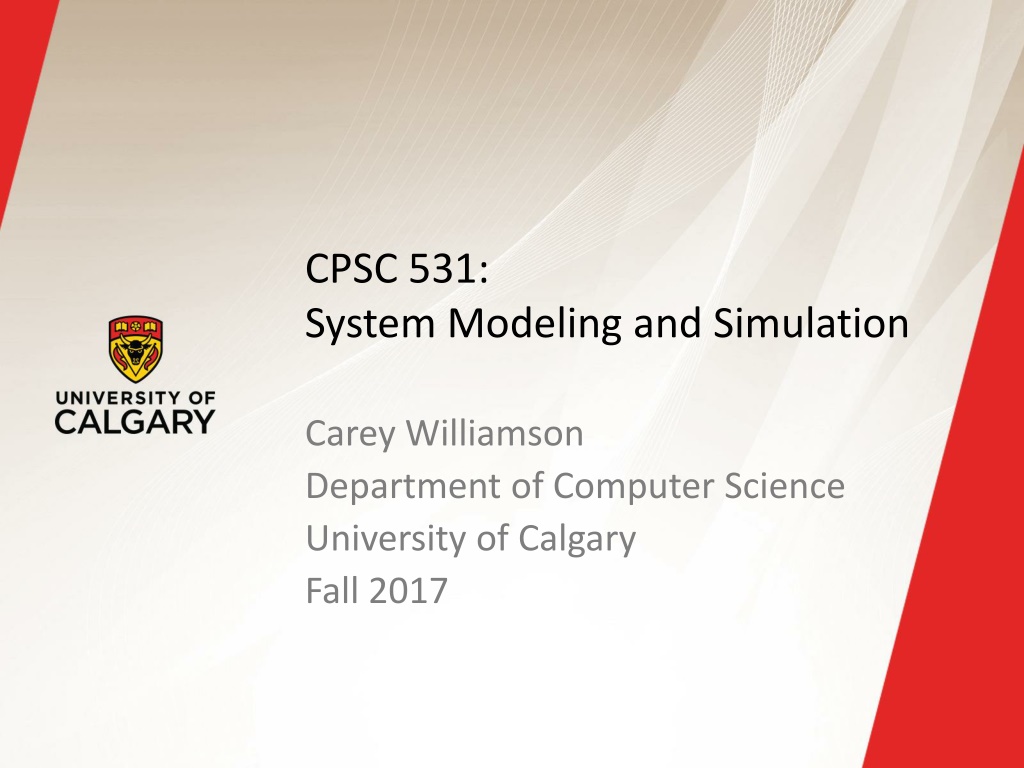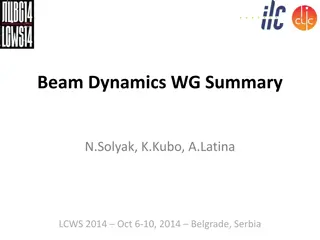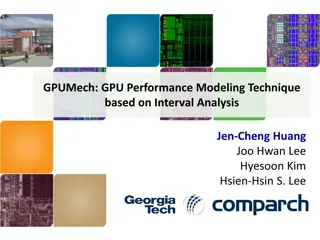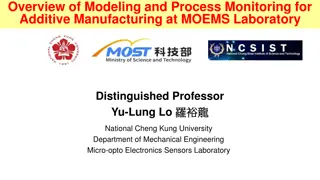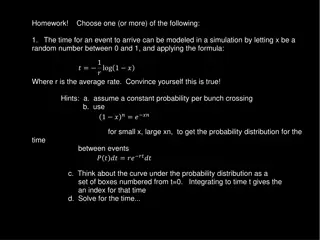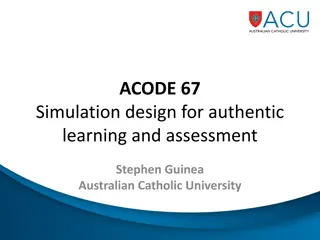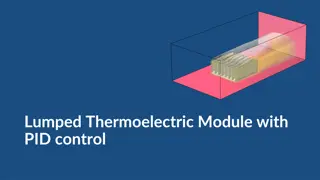System Modeling and Simulation Overview
This content provides insights into CPSC 531: System Modeling and Simulation course, covering topics such as performance evaluation, simulation modeling, and terminology in system modeling. It emphasizes the importance of developing simulation programs, advantages of simulation, and key concepts like system environment, entity, attribute, state, and event. The material also includes visual aids and a quote on the challenges of simulation modeling.
Download Presentation

Please find below an Image/Link to download the presentation.
The content on the website is provided AS IS for your information and personal use only. It may not be sold, licensed, or shared on other websites without obtaining consent from the author.If you encounter any issues during the download, it is possible that the publisher has removed the file from their server.
You are allowed to download the files provided on this website for personal or commercial use, subject to the condition that they are used lawfully. All files are the property of their respective owners.
The content on the website is provided AS IS for your information and personal use only. It may not be sold, licensed, or shared on other websites without obtaining consent from the author.
E N D
Presentation Transcript
CPSC 531: System Modeling and Simulation Carey Williamson Department of Computer Science University of Calgary Fall 2017
Recap: Performance Evaluation Performance Evaluation Performance Measurement Performance Modeling Analytic Modeling Simulation 2
Terminology (1 of 2) A system is defined as a group of objects that interact with each other to accomplish some purpose A computer system: CPU, memory, disk, bus, NIC An automobile factory: Machines, components parts and workers operate jointly along assembly line A system is often affected by changes occurring outside the system: system environment Hair salon: arrival of customers Warehouse: arrival of shipments, fulfilling of orders Effect of supply on demand: relationship between factory output from supplier and consumption by customers 4
Terminology (2 of 2) Entity An object of interest in the system: Machines in factory Attribute The property of an entity: speed, capacity, failure rate State A collection of variables that describe the system in any time: status of machine (busy, idle, down, ) Event An instantaneous occurrence that might change the state of the system: breakdown 5
Simulation Modeling Develop a simulation program that implements a computational model of the system of interest Run the simulation program and use the data collected to estimate the performance measures of interest (often involves the use of randomization) A system can be studied at an arbitrary level of detail Quote of the day: The hardest part about simulation is deciding what NOT to model. - Moe Lavigne, Stentor, Summer 1995 6
Advantages of Simulation New policies and procedures can be explored without disrupting the ongoing operation of the real system New designs can be tested without committing resources for their acquisition Time can be compressed or expanded to allow for a speed-up or slow-down of the phenomenon under study Insight can be obtained about the interactions of variables, and which ones have the most impact on system performance Can obtain answers to What if questions 7
Disadvantages of Simulation Model building requires special training An important role for courses like CPSC 531!! Vendors of simulation software have been actively developing packages that contain models that only need input (templates), which simplifies things for users Simulation results can be difficult to interpret Need proper statistical interpretation for output analysis Simulation modeling and analysis can be time- consuming and expensive, both for the modeler, as well as in compute time (if not done judiciously) 8
When Simulation Is Not Appropriate When the problem can be solved by common sense When the problem can be solved analytically When it is easier to perform direct experiments When cost of simulations exceeds (expected) savings for the real system When system behavior is too complex (e.g., humans) 9
Common Mistakes in Simulation Poor (pseudo) random number generators Best to use well-known or well-understood generator Improper selection of seeds for PRNG Short periods; same seeds for all streams Inappropriate level of detail: More detail more time more bugs More parameters more accurate Improperly handled initial conditions (warmup) Improperly handled ending conditions (cooldown) Run-length too short to achieve steady-state Need proper output analysis, confidence intervals 10
Types of Simulations Monte Carlo simulation Time-stepped simulation Trace-driven simulation Discrete-event simulation Continuous simulation 11
Simulation Examples Monte Carlo simulation (see Assignment 1) Estimating Craps (dice game) Time-stepped simulation Mortgage scenarios Trace-driven simulation (see Assignment 2) Single-server queue (ssq1.c) Discrete-event simulation (see Assignments 3 and 4) Witchcraft hair salon 13
Monte Carlo Simulation Named after Count Montgomery de Carlo, who was a famous Italian gambler and random- number generator (1792-1838). Static simulation (no time dependency) To model probabilistic phenomenon Can be used for evaluating non-probabilistic expressions using probabilistic methods Can be used for estimating quantities that are hard to determine analytically or experimentally 14
Trace-Driven Simulation Trace = time-ordered record of events in system Trace-driven simulation = Trace input Often used in evaluating or tuning resource management algorithms (based on real workloads): Paging, cache analysis, CPU scheduling, deadlock prevention, dynamic storage allocation Example: Trace = start time + duration of processes Example: Trace = size in bytes of file written to disk Example: Trace = mobile device ID and call duration 15
Advantages of Trace-Driven Simulations Credibility Easy validation: compare simulation with measurement Accurate workload: models correlation and interference Fair comparison: better than random input Similarity to the actual implementation: trace-driven model is similar to the system can understand complexity of implementation 16
Disadvantages of Trace-Driven Simulations Complexity: more detailed Representativeness: workload changes with time, equipment Data Collection: few minutes fill up a disk Instrumentation: granularity; intrusiveness Single Point of Validation: one trace = one point Difficult to change workload 17
Discrete-Event Simulation A simulation model with three features: 1. Stochastic: some variables in the simulation model are random 2. Dynamic: system state evolves over time 3. Discrete-Event: changes in system state occur at discrete time instances 18
Discrete and Continuous Systems A discrete system is one in which the system state changes only at a discrete set of points in time Example: A restaurant 19
Discrete and Continuous Systems A continuous system is one in which the system state changes continuously over time Example: Water level in Bow River (or Bearspaw dam) 20
Discrete-Event Simulation A simulation model in which system state evolves over a discrete sequence of events in time System state changes only when an event occurs System state does not change between the events Departure Arrival Arrival Arrival Restaurant Example 21
Continuous Simulation A simulation model in which system state evolves continuously over time Time is divided to small time slices System state changes in every time slice Dam Example 22
Characterizing a Simulation Model Deterministic or Stochastic Does the model contain stochastic components? Static or Dynamic Is time a significant variable? Continuous or Discrete Does the system state evolve continuously or only at discrete points in time? 23
DES Model Development How to develop a simulation model: 1. Determine the goals and objectives 2. Build a conceptual model 3. Convert into a specification model 4. Convert into a computational model 5. Verify the model 6. Validate the model Typically an iterative process 25
Three Model Levels Conceptual Model Very high level (perhaps schematic diagram) How comprehensive should the model be? What are the state variables? Which ones are dynamic, and which are most important? Specification Model On paper: entitites, interactions, requirements, rules, etc. May involve equations, pseudocode, etc. How will the model receive input? Computational Model A computer program General-purpose programming language or simulation language? 26
Simulation Software General purpose programming languages Flexible and familiar Well suited for learning DES principles and techniques E.g., C++, Java Simulation programming languages Good for building models quickly Provide built-in features (e.g., queue structures) Graphics and animation provided Domain specific Network protocol simulation: ns2, Opnet Electrical power simulation: ETAP Design and engineering: Ansys, Autodesk Process simulation: Simul8 27
Verification and Validation Verification Computational model should be consistent with specification model Did we build the model right? Validation Computational model should be consistent with the system being analyzed Did we build the right model? Can an expert distinguish simulation output from system output? 28
